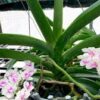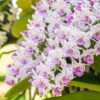# Guide to Harvesting and Storing Seeds of Dendrobium Anosmum (Đai Châu Orchid)

Dendrobium anosmum, commonly known as Đai Châu orchids, are admired for their stunning flowers and are widely cultivated for ornamental purposes. Harvesting and properly storing their seeds is a critical aspect of propagation, enabling orchid enthusiasts to ensure the continuation of this beautiful species. This comprehensive guide will provide step-by-step instructions on how to harvest Dendrobium anosmum seeds, along with effective storage methods to maintain their viability for future planting.
## Understanding Dendrobium Anosmum
### Characteristics of Dendrobium Anosmum
Before diving into the harvesting and storage process, it’s essential to understand the unique characteristics of Dendrobium anosmum:
– **Flowering Cycle**: Dendrobium anosmum typically blooms in the spring, producing clusters of fragrant flowers that can range in color from white to shades of purple and pink.
– **Growth Habit**: This orchid has a distinctive growth habit with long, slender stems that can grow up to 1 meter (3 feet) in length. After flowering, the stems will develop seed pods that contain the seeds.
– **Seed Structure**: The seeds of Dendrobium anosmum are tiny, dust-like, and highly delicate, making them susceptible to damage during the harvesting process. Understanding their structure is vital for successful collection and storage.
## The Harvesting Process
### 1. Identifying the Right Time to Harvest
The timing of seed harvesting is crucial for maximizing seed viability:
– **Seed Pod Maturity**: After flowering, seed pods will develop along the stem. Wait until the seed pods turn brown and begin to split open. This indicates that the seeds are mature and ready for harvest.
– **Observation**: Keep a close eye on the pods. Once they start to split, it’s essential to act quickly, as seeds can be dispersed by wind or other environmental factors.
### 2. Tools Required for Harvesting
Before you begin harvesting, gather the necessary tools to ensure a smooth process:
– **Sharp Scissors or Pruners**: Use these to cut the seed pods without damaging the plant.
– **Paper Towels or Containers**: Prepare a clean, dry surface or containers to collect the seeds.
– **Labels**: Use labels to mark the harvested seeds with details such as the plant’s name, date of harvest, and any other relevant information.
### 3. Harvesting the Seeds
Follow these steps for effective harvesting:
– **Cut the Seed Pods**: Using sharp scissors or pruners, carefully cut the seed pods from the stem. Ensure that you do not damage the remaining plant.
– **Collect the Seeds**: Hold the cut seed pod over a paper towel or container and gently squeeze or tap it to release the seeds. Be careful, as the seeds are very lightweight and can easily be lost if not handled properly.
– **Repeat the Process**: Continue harvesting pods from multiple plants, if applicable, to ensure a diverse gene pool in your seed collection.
## Cleaning the Seeds
After harvesting, it’s essential to clean the seeds to remove any debris:
– **Remove Debris**: Gently sift through the collected seeds to remove any remaining pieces of the seed pod or other plant material.
– **Air Dry**: Spread the seeds on a clean, dry surface, such as a paper towel, to air dry for a few hours. This helps to reduce moisture content, which is critical for successful storage.
## Storing Dendrobium Anosmum Seeds
### 1. Understanding Seed Viability
Dendrobium anosmum seeds are highly sensitive to environmental conditions. Understanding their viability and storage needs is essential:
– **Longevity**: When stored correctly, Dendrobium anosmum seeds can remain viable for several years. However, factors such as temperature, humidity, and light exposure can significantly impact their longevity.
– **Moisture Content**: Seeds should be kept as dry as possible to prevent mold growth and premature germination.
### 2. Choosing the Right Storage Method
There are several effective methods for storing Dendrobium anosmum seeds:
#### Airtight Containers
– **Glass or Plastic Jars**: Use clean, airtight glass or plastic jars to store the seeds. Ensure that the containers are dry before adding the seeds.
– **Silica Gel Packets**: To further reduce moisture, consider adding silica gel packets inside the jar. These packets will absorb excess humidity and help maintain an optimal environment for the seeds.
#### Seed Envelopes
– **Paper Envelopes**: For smaller quantities of seeds, use paper envelopes labeled with the plant’s name and date of harvest. Place the envelopes inside an airtight container for added protection.
– **Avoid Plastic Bags**: While plastic bags can be convenient, they may trap moisture, which can lead to mold and seed spoilage.
### 3. Ideal Storage Conditions
To ensure the longevity of your Dendrobium anosmum seeds, follow these guidelines:
– **Cool Temperatures**: Store the seeds in a cool, dark place. Ideally, a temperature between 4-10°C (39-50°F) is optimal for seed preservation.
– **Low Humidity**: Keep humidity levels below 30%. Use a hygrometer to monitor humidity if you are storing large quantities of seeds.
## Labeling and Record Keeping
### 1. Importance of Labeling
Labeling your seeds is crucial for effective tracking and organization:
– **Plant Information**: Clearly mark each container or envelope with the plant name, date of harvest, and any relevant notes regarding the seed’s origin or characteristics.
– **Tracking Germination**: Maintain a record of the harvesting and storage dates, as well as germination success rates for future reference.
### 2. Record Keeping System
Implementing a record-keeping system will help you manage your seed collection effectively:
– **Seed Inventory**: Create a spreadsheet or notebook to track your seed inventory, including details such as seed type, quantity, and storage location.
– **Germination Testing**: Periodically test a small sample of seeds for germination to assess viability. This information can inform your future planting decisions.
## Germinating Dendrobium Anosmum Seeds
### 1. Preparing for Germination
Once you are ready to propagate your Dendrobium anosmum seeds, preparation is key:
– **Growing Medium**: Choose a suitable growing medium, such as a fine orchid mix or a seed-starting mix. Ensure that the medium is sterile to prevent disease.
– **Containers**: Use shallow trays or seedling pots to facilitate easy monitoring of growth.
### 2. Sowing the Seeds
Follow these steps for successful sowing:
– **Moistening the Medium**: Before sowing, moisten the growing medium with water to ensure it is damp but not soggy.
– **Sprinkling Seeds**: Gently sprinkle the seeds evenly over the surface of the medium. Do not bury them, as Dendrobium seeds require light for germination.
– **Covering**: Lightly mist the surface to ensure the seeds make good contact with the medium.
### 3. Providing Optimal Conditions
Creating the right environment is crucial for germination:
– **Humidity Dome**: Cover the trays with a humidity dome or plastic wrap to maintain high humidity levels. Ensure there is ventilation to prevent mold growth.
– **Temperature and Light**: Place the trays in a warm location with indirect light. The ideal temperature for germination is around 20-25°C (68-77°F).
### 4. Monitoring Growth
After sowing, monitor the seeds regularly:
– **Watering**: Check the moisture level of the growing medium. Mist lightly as needed to prevent drying out while avoiding excessive watering.
– **Ventilation**: Remove the humidity dome periodically to allow fresh air exchange and prevent mold.
### 5. Transplanting Seedlings
Once the seedlings develop a few sets of true leaves, they are ready for transplanting:
– **Transplant Timing**: This usually occurs 8-12 weeks after sowing, depending on the growing conditions.
– **Transplanting Process**: Gently lift the seedlings from the tray, being careful not to damage their delicate roots. Transplant them into individual pots with a suitable orchid mix.
## Conclusion
Harvesting and storing the seeds of Dendrobium anosmum (Đai Châu orchid) is a rewarding process that ensures the continued beauty and diversity of this species. By following the steps outlined in this guide, from identifying the right time for harvesting to implementing effective storage methods, you can successfully propagate and cultivate these stunning orchids.
Understanding the needs of Dendrobium anosmum seeds throughout the harvesting, storage, and germination process is essential for any orchid enthusiast. With patience and care, you can enjoy the beauty of these orchids in your home and contribute to their preservation for future generations. Happy gardening!

